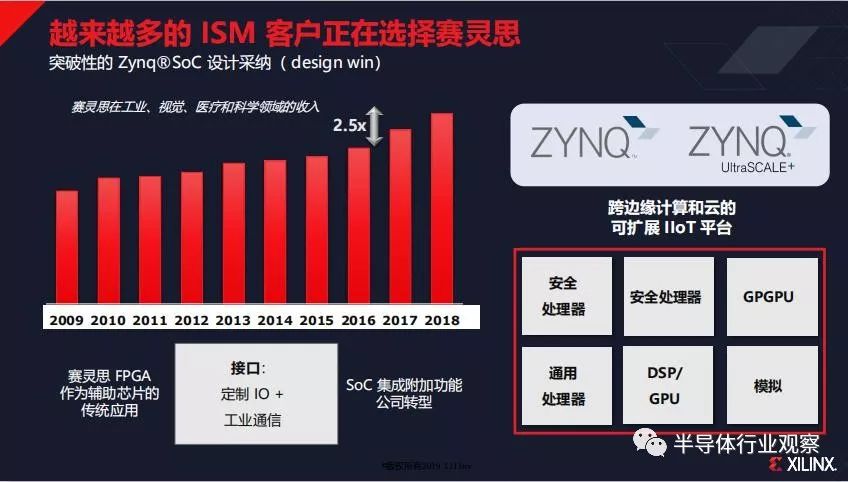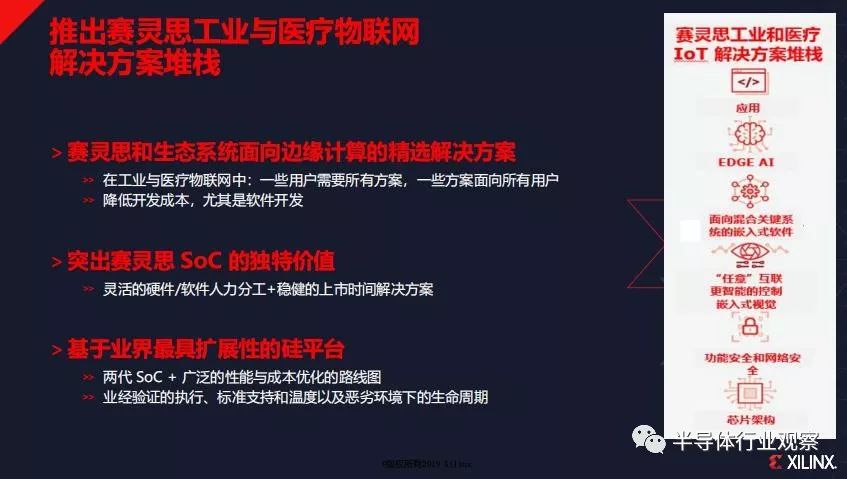In recent years, the development of the Internet of Things has brought new vitality to the industrial and medical fields. As a result, the innovation of the Industrial Internet of Things (IIoT) and the Medical Internet of Things (HcIoT) has also emerged. The rise of these emerging fields has provided opportunities for the development of FPGAs. As a leader in the FPGA industry, how does Xilinx perform in the fields of Industrial Internet of Things and Medical Internet of Things?

Mr. Chetan Khona, Director of Industrial, Vision, Medical and Scientific (ISM) Marketing at Xilinx
SoC drives industrial business
Xilinx's financial report last year showed that Xilinx's revenue in fiscal 2019 increased by 24% year-on-year to US$3 billion. Among them, the industrial and medical sectors accounted for 27% of the total revenue. Chetan Khona, Xilinx's industrial, vision, medical and scientific (ISM) marketing director, said: "The ISM department is also Xilinx's fourth largest business unit. This department aims to create flexible and intelligent factories, hospitals and cities."

According to Chetan Khona, in today's industrial Internet of Things and data acceleration, FPGA stands at the center of the stage, but it is Zynq SoC that really drives Xilinx's business in the industrial field. He believes that for industrial and medical users, size and price are very important, and Xilinx SoC product series can provide them with higher value in this field.
This view is also reflected in Xilinx's revenue report. From the ISM revenue released by Xilinx, although traditional FPGAs have maintained a certain growth, in the past two years, after the Zynq and Zynq UltraScale+ SoCs went into production, Xilinx's ISM department's revenue has been significantly accelerated, reaching 2.5 times. It can be said that SoC products have brought huge value to Xilinx's ISM department.

Opportunities and challenges that data brings to IIoT and HcIoT
As mentioned above, IIoT and HcIoT are bringing new inspiration to the industry. The explosion of data brought about by the rise of the Internet of Things has also brought new strengths to Xilinx. What are the benefits of data and how to use data have also become issues worth thinking about.
For the industrial Internet of Things, firstly, data can be used for predictive maintenance, which can minimize factory downtime and thus ensure profitability and profits; secondly, data can be used to better understand customer purchasing habits through asset analysis, thereby creating new revenue streams; and thirdly, connectivity, which is the foundation of the Internet of Things and the Industrial Internet. Updating software and hardware through Xilinx solutions can extend the life of products, thereby reducing the cost of replacement.
For the medical Internet of Things, data can better improve the work efficiency of hospitals and clinics, thereby improving time utilization, improving services to patients, and ultimately improving people's quality of life.

The data explosion has brought a very promising prospect to the semiconductor industry, but at the same time, the application of data has also brought many challenges. The first and foremost issue is the privacy issue brought by data, especially with the change of time and the growth of computing power, security will face greater challenges. In addition, the latency and responsiveness issues that affect security; the data management costs including transmission, storage and processing; and reliable Internet connections are all data issues that need to be solved in the IoT revolution.

Take the medical Internet of Things as an example. Currently, more than 100 million medical Internet of Things devices have been installed worldwide, and this number will grow to 161 million by 2020. However, some medical executives also said that the three major obstacles that currently hinder medical organizations from adopting the Internet of Things are: privacy issues account for 59%, existing system integration issues account for 55%, and security issues account for 54%. This shows that improvements in data processing and security have brought great development space to the semiconductor industry.
In response to the above challenges, what Xilinx needs to do is to help users use data as efficiently and effectively as possible. At the same time, this is also the core strategy of the company's ISM department.
Xilinx Industrial and Vision Solutions Overview
To ensure that FPGA and SoC users can maximize computing power and efficiency on existing devices, Xilinx provides a variety of resources.
According to Chetan Khona, the world-class industrial and medical IoT solution stack, acceleration for industrial PCs using Alveo accelerator cards, and complementary edge and cloud collaboration are the three secret weapons of the ISM department.
As for the world-class industrial and medical IoT solution stack, Xilinx can provide a full range of solutions, including helping customers develop the products they need for better applications by providing secure connectivity, control, vision, circuits, software and artificial intelligence. At the same time, Chetan Khona also said that Xilinx is not an expert in all fields, so we will also use the expertise, technology and knowledge capabilities in a very broad ecosystem to help users get the solutions they need.

As we all know, industrial real-time and deterministic control and interface, industrial life cycle, quality, reliability, safety, temperature and power consumption are Xilinx's traditional advantages in the industrial field, but this cannot become an advantage for Xilinx to form differentiated competition with other companies. To this end, Xilinx combines AI latency and performance with traditional advantages, and combines SoC with artificial intelligence, ensuring a high degree of device integration and achieving high cost effectiveness.

In terms of artificial intelligence, Xilinx has improved its edge computing capabilities through the acquisition of DeePhi Technology. This capability enables Xilinx to support high-throughput and low-latency artificial intelligence, match the rapid pace of artificial intelligence innovation, and accelerate overall applications. At the same time, with a comprehensive AI software platform, Xilinx can achieve innovation in industrial and medical IoT in AI edge computing.
In addition, according to Chetan Khona's introduction, we also learned that Xilinx ISM department also pays attention to the integration of cloud and edge computing. Chetan Khona said: "For industrial and medical Internet, the latency of data processing in the cloud is very high, which is not conducive to the development of massive data transmission."

To improve this situation and enable data to be reasonably distributed to the cloud and edge for processing, Xilinx is working with Amazon Cloud Services. Chetan Khona said: "Using the functions of Amazon's Greengrass framework, the cloud can be moved to the edge. In this way, the system greatly reduces data transmission and latency when it is running. In addition, Xilinx is also working with Alibaba Cloud, Microsoft Azure, Google, and IBM in this regard."
Development route
Based on the three strategic elements of the ISM department, Xilinx launched Zynq and Zynq UltraScale+ SoC. Through Zynq and Zynq UltraScale+ SoC, general-purpose processing DSP, GPU and simulation, security processor and security processor are integrated into the same product, providing new options for the industrial and medical Internet of Things.
In the industrial product roadmap released by Xilinx, in addition to the familiar FPGA, SoC, MPSoC, and RFSoC, we also saw Zynq SoC and Zynq UltraScale+ SoC. At the same time, ACAP is the next development element of Xilinx. In its first product series Versal, we also found a product for the industrial field - AI Edge. According to reports, AI Edge emphasizes low power consumption and high performance, and can be used in systems such as machine vision, ultrasound equipment, and ultrasound handheld devices.

According to Chetan Khona, Edge AI is both a capability and a sub-series of Versal. Currently, both Zynq SoC and Zynq UltraScale+ SoC have deployed Edge AI, and in the future it will be a sub-series of Versal, mainly to achieve industry-leading performance per watt. Chetan Khona believes that after the deployment in this field is completed, Zynq UltraScale+ SoC will become the most successful product in the Xilinx product series in the industrial Internet of Things and medical Internet of Things.
Previous article:Interview: What does OTA manufacturer Ailabi think of the Internet of Things?
Next article:ST releases 2019 Sustainability Report
Recommended ReadingLatest update time:2024-11-15 15:02








- e-Network Community and NXP launch Smart Space Building Automation Challenge
- The Internet of Things helps electric vehicle charging facilities move into the future
- Nordic Semiconductor Launches nRF54L15, nRF54L10 and nRF54L05 Next Generation Wireless SoCs
- Face detection based on camera capture video in OPENCV - Mir NXP i.MX93 development board
- The UK tests drones equipped with nervous systems: no need to frequently land for inspection
- The power of ultra-wideband: reshaping the automotive, mobile and industrial IoT experience
- STMicroelectronics launches highly adaptable and easy-to-connect dual-radio IoT module for metering and asset tracking applications
- This year, the number of IoT connections in my country is expected to exceed 3 billion
- Infineon Technologies SECORA™ Pay Bio Enhances Convenience and Trust in Contactless Biometric Payments
- LED chemical incompatibility test to see which chemicals LEDs can be used with
- Application of ARM9 hardware coprocessor on WinCE embedded motherboard
- What are the key points for selecting rotor flowmeter?
- LM317 high power charger circuit
- A brief analysis of Embest's application and development of embedded medical devices
- Single-phase RC protection circuit
- stm32 PVD programmable voltage monitor
- Introduction and measurement of edge trigger and level trigger of 51 single chip microcomputer
- Improved design of Linux system software shell protection technology
- What to do if the ABB robot protection device stops
- Analysis of the application of several common contact parts in high-voltage connectors of new energy vehicles
- Wiring harness durability test and contact voltage drop test method
- From probes to power supplies, Tektronix is leading the way in comprehensive innovation in power electronics testing
- From probes to power supplies, Tektronix is leading the way in comprehensive innovation in power electronics testing
- Sn-doped CuO nanostructure-based ethanol gas sensor for real-time drunk driving detection in vehicles
- Design considerations for automotive battery wiring harness
- Do you know all the various motors commonly used in automotive electronics?
- What are the functions of the Internet of Vehicles? What are the uses and benefits of the Internet of Vehicles?
- Power Inverter - A critical safety system for electric vehicles
- Analysis of the information security mechanism of AUTOSAR, the automotive embedded software framework
- 【Iprober 520 Current Probe】Evaluation Report (II) Basic Performance Test
- MicroPython Hands-on (28) - Yeelight for the Internet of Things
- Allegro cannot be installed due to VC2005. Is there any way to fix this?
- Has anyone used Sensortile Box? Please help~
- The serial clock SCL and serial data SDA of the PROM are connected to the master MCU and then to the SC of the clock IC...
- Cost-cutting design cannot be delayed
- The MP3 purchased with E coins has arrived. It’s never too late to learn English!
- EEWORLD University Hall----Live Replay: Renesas RA MCU family members grow rapidly, helping to build safe and stable industrial control systems
- MSP430F5529 library functions
- A seemingly reasonable PCB design, why does the step area on the board bubble after welding?

 MATLAB and FPGA implementation of wireless communication
MATLAB and FPGA implementation of wireless communication
















 京公网安备 11010802033920号
京公网安备 11010802033920号